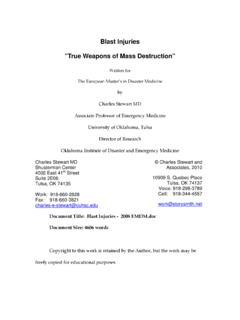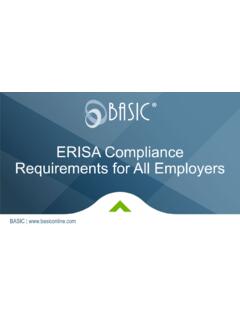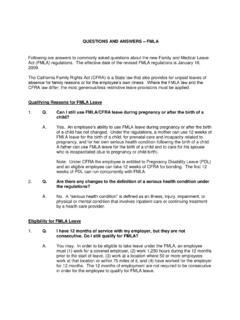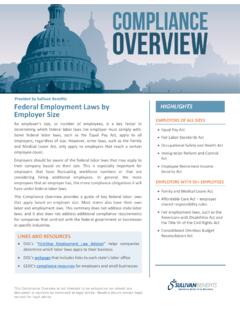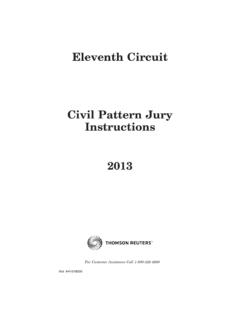Transcription of USERRA Facts for Employers - AZ1-DMAT
1 USERRA Facts for Employers of NDMS Members Note: This material is for information only and should not be considered as legal authority. While this fact sheet is directed to civilian Employers of members of the National Disaster Medical System, it should be noted that Active component members, Public Health Service Commissioned Corps members, and certain others are also protected by the Uniformed Services Employment and Reemployment Rights Act ( USERRA ), if they meet the eligibility criteria. Contact the Committee for Employer Support of the Guard and Reserve at (800) 336-4590 with specific questions regarding USERRA . If you need more information concerning specific situations, call the ESGR at (800) 336- 4590.
2 Note: Where applicable, a relevant section number of Title 38 or Title 42, United States Code, is provided in parentheses after the answer. 1. One of my employees has just notified me that she is a member of the National Disaster Medical System (NDMS), Federal Emergency Management Agency (FEMA). She also just notified me that she has been asked by NDMS to deploy to Florida tomorrow for hurricane victim medical assistance duty. She told me that she has the option to turn down an NDMS deployment, and I am short employees and need her to be at work for our organization. Do I have the right to refuse her request for leave of absence to do NDMS duty?
3 No. The Uniformed Services Employment and Reemployment Rights Act ( USERRA ), as codified at Title 38, Code, as amended by Title 42, Code section 300hh-11(e), provides that NDMS members are intermittent federal employees considered members of the uniformed services for all purposes of USERRA . Under USERRA , if a member of the uniformed services, including an NDMS member, provides the employer with advance notice, when practical, of federal activation on behalf of NDMS, even if such activation is voluntary service, the employer must allow the employee leave of absence and reinstate them to their prior employment (or equivalent employment) upon the employee's request.
4 There is no small business or employer hardship exception to federal deployment/activation. (38 USC 4312). 2. Is there a law governing a service member's/NDMS member's right to reemployment rights after his or her completion of military/NDMS training or federal active service? Yes. Since 1940, there has been such a law, known as the Veterans' Reemployment Rights Act (VRRA). On October 13, 1994, President Clinton signed the Uniformed Services Employment and Reemployment Rights Act a comprehensive revision of the VRRA, USERRA became fully effective December 12, 1994, and is contained in Title 38, United States Code, at chapter 43.
5 (Sections 4301 through 4333). NDMS. members received USERRA protections in 2002, by Act of Congress, codified at 42 Code 300hh-11(e), Pub. L. 107-188, Section 102(a), June 12, 2002. (42 USC 300hh- 11(e)). 3. Who is eligible for reemployment rights under USERRA following military/NDMS federal active service? The individual must meet five conditions, or "eligibility criteria." The individual: a. must hold or have applied for a civilian job. (Note: Jobs Employers can show to be held for a brief, nonrecurring period with no reasonable expectation of continuing for a significant period do not qualify for protection.). b. must have given written or verbal notice to the civilian employer prior to leaving the job for military/NDMS training or service except when precluded by military/NDMS necessity.
6 C. must not have exceeded the 5-year cumulative limit on periods of active federal service. d. must have been released from service under conditions other than dishonorable for military reservists and Guard, and must not have been terminated for misconduct while serving on a federal status, if an NDMS member. e. must report back to the civilian job in a timely manner or submit a timely application for reemployment. (generally, 38 USC 4312). 3. Are there reemployment rights following voluntary military/NDMS service? State or local government call ups? USERRA applies to voluntary as well as involuntary military / NDMS service, in peacetime as well as wartime.
7 However, like the VRR law, USERRA does not apply to state or local government call ups of the National Guard or NDMS. organization/personnel for disaster relief, riots, etc. The laws of the state or territory must provide protection for any such duty involved. (38 USC 4303). 4. When is prior notice to the civilian employer required? How is such notice to be given? The person who is performing the service (or an official representative of the uniformed service or NDMS) must give advance written or verbal notice to the employer. The notice requirement applies to all categories of training or service. Notice is not required if precluded by military/NDMS necessity or, if the giving of such notice is otherwise impossible or unreasonable under the circumstances.
8 A determination of military/NDMS necessity shall be made pursuant to regulations prescribed by the Department of Defense or DHS/FEMA for NDMS personnel. It is reasonable to expect that situations where notice is not required will be rare. The law does not specify how much advance notice is required, but the Department of Defense and Department of Homeland Security/FEMA advises members of the National Guard 2. and Reserve and NDMS that they should provide their Employers as much advance notice as they can. (38 USC 4312). 5. Is an employer entitled to proof that military/NDMS duty for which an employee was granted a leave of absence was actually performed?
9 Yes. USERRA provides that following periods of military/federal NDMS service of 31. consecutive days or more, the returning employee must, upon the employer's request, provide documentation that establishes length and character of the service and the timeliness of the application for reemployment. Reemployment may not be delayed, however, if such documentation does not exist or is not readily available. In general, the following documents have been determined by the Secretary of Labor to satisfy proof of eligibility for reemployment: discharge papers, leave and earnings statements, school completion certificate, endorsed orders, or a letter from a proper military/NDMS.
10 Authority. While USERRA does not address documentation of shorter periods of military service, if doubt exists, an employer could contact the employee's military command/NDMS supervisors with questions about a specific period of service. (38 USC. 4312). 6. How is the 5-year limit computed? Service in the uniformed services, except the types of service described below, counts toward the cumulative 5-year limit of military/active federal NDMS service a person can perform while retaining rights under USERRA . When a person starts a new job with a new employer, he or she receives a fresh 5-year entitlement. Duty performed prior to the effective date of USERRA is addressed in question #8.
